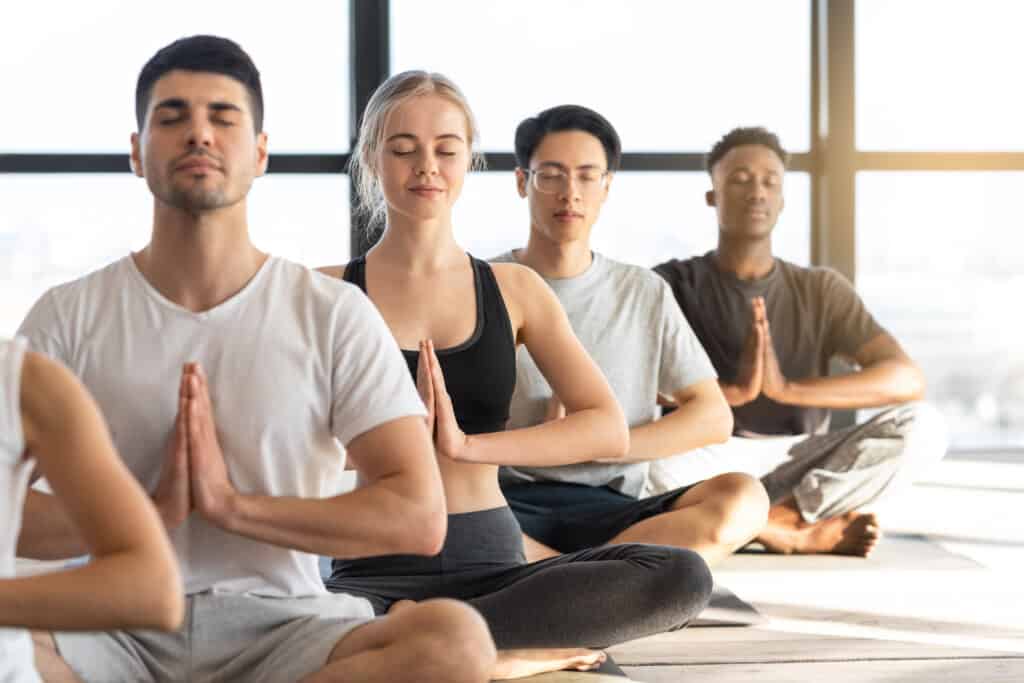Aspiring yoga teachers often wonder about the necessary qualifications for entering this rewarding field. To become a certified yoga teacher, one typically needs to complete a minimum of a 200-hour teacher training program, which covers essential topics like yoga philosophy, anatomy, and teaching methodologies. This foundational training is crucial for anyone looking to share their passion for yoga with others.

In addition to formal education, practical experience and ongoing professional development are vital. Many successful instructors also emphasize the importance of cultivating personal practice, maintaining ethical conduct, and understanding the business aspects of teaching yoga. By focusing on these areas, individuals can enhance their skills and effectively connect with their students.
Key Takeaways
- A 200-hour training program is the basic requirement for certification.
- Continuous learning and teaching experience are essential for growth.
- Understanding professional conduct helps in building credibility as a teacher.
Fundamentals of Yoga Teaching

Understanding yoga teaching requires a grasp of its history and philosophy, various styles and practices, and the anatomy and physiology relevant to yoga. These foundational elements prepare aspiring teachers to guide their students effectively.
History and Philosophy of Yoga
Yoga has a rich history dating back over 5,000 years in ancient India. It encompasses various texts, with the Yoga Sutras of Patanjali being one of the most important philosophical foundations.
Philosophy in yoga includes concepts like Ahimsa (non-violence) and Satya (truthfulness), which inform the ethical framework for teachers. Understanding these principles allows instructors to cultivate a respectful and compassionate environment during classes.
Throughout its evolution, yoga has integrated various beliefs, adapting to cultures, which results in diverse interpretations and practices today.
Styles and Practices of Yoga
There are several distinct styles of yoga, each with its focus and techniques. Common styles include:
- Hatha: A foundational style focusing on physical postures.
- Vinyasa: Emphasizes breath with movement in flowing sequences.
- Ashtanga: A rigorous style featuring a set series of postures.
- Yin: Involves long-held postures to target deep connective tissues.
Each style offers unique benefits and appeals to different populations. Understanding these styles enables teachers to tailor their approach according to students’ needs.
Anatomy and Physiology Related to Yoga
Knowledge of anatomy and physiology is crucial for yoga teachers. Key areas of focus include the skeletal and muscular systems, as well as basic concepts of biomechanics. This understanding helps instructors design safe and effective classes.
Teachers must recognize how poses affect body alignment and function. For instance, an awareness of how certain postures impact the spine can assist in preventing injuries.
Incorporating this knowledge into teaching will promote physical well-being among students and enhance their overall experience in yoga practice.
Yoga Teacher Certification
Yoga teacher certification is crucial for those aspiring to teach yoga professionally. The most recognized programs typically fall into several categories, each offering different depths of training and knowledge.
200-Hour Yoga Teacher Training Program
A 200-hour yoga teacher training program is the foundational certification required for becoming a yoga instructor. This program usually encompasses various aspects of yoga, including asana practice, anatomy, philosophy, and teaching methodology.
Participants will engage in hands-on practice, learning how to lead a class, adjust postures, and create a safe environment for students.
Programs certified by Yoga Alliance are highly valued, ensuring adherence to established standards. Completing this training equips individuals with essential skills and confidence to begin teaching yoga.
500-Hour Yoga Teacher Training Program
The 500-hour yoga teacher training program is an advanced certification that builds upon the foundational 200-hour program. This extensive training delves deeper into subjects such as advanced anatomy, specific styles of yoga, and refined teaching techniques.
Many programs offer specialization options, allowing instructors to focus on areas like restorative yoga, therapeutic approaches, or prenatal yoga.
Participants gain advanced skills and enhanced knowledge, preparing them for more complex student needs and diverse teaching environments. This certification is often sought by dedicated practitioners aiming for a deeper commitment to their teaching journey.
Specialty Yoga Certifications
Specialty yoga certifications allow instructors to gain expertise in specific styles or populations. Options may include certifications in areas such as:
- Children’s Yoga: Tailored to teaching yoga to younger audiences.
- Therapeutic Yoga: Focuses on adapting yoga practices for healing and rehabilitation.
- Prenatal Yoga: Targets the unique needs of pregnant individuals.
Each specialty program typically requires additional training hours and may have prerequisites based on skill level.
These certifications enhance an instructor’s marketability and expand their teaching scope, catering to niche groups while providing specialized knowledge.
Essential Skills for Yoga Instructors
To be an effective yoga instructor, one must possess a blend of communication abilities, instructional techniques, and classroom management skills. Mastering these skills contributes significantly to a positive learning environment and enhances the overall experience for students.
Effective Communication
Effective communication is vital for yoga instructors. They must convey instructions clearly and concisely, ensuring students understand poses and transitions.
Key aspects include:
- Verbal Clarity: Using straightforward language that is easy to understand.
- Demonstration: Showing poses accurately, reinforcing verbal instructions.
- Feedback: Offering constructive feedback helps students improve without discouragement.
Instructors also need active listening skills. This allows them to gauge students’ needs and address any concerns, fostering a supportive atmosphere.
Instructional Techniques
Instructors should employ various instructional techniques to accommodate different learning styles among students. Understanding the fundamentals of anatomy and alignment will aid in providing safer yoga practices.
Important techniques include:
- Progressive Instruction: Starting with basic poses before advancing to complex sequences.
- Modifications: Offering alternatives for various ability levels ensures everyone can participate.
- Sequencing: Structuring classes to flow logically from warm-up to cool-down allows for an effective practice.
Incorporating these techniques keeps students engaged and promotes safer practices.
Classroom Management
Classroom management skills are essential for maintaining a focused and respectful environment. Instructors must handle disruptions gracefully and keep students engaged.
Key management strategies include:
- Setting Expectations: Clearly communicating class rules at the beginning helps maintain order.
- Monitoring Energy Levels: Adjusting pace based on students’ responses keeps engagement high.
- Inclusivity: Encouraging a supportive atmosphere fosters respect and camaraderie among students.
These skills collectively contribute to a well-organized class, making for a more enjoyable experience for all participants.
Practical Experience

Practical experience is essential for anyone aspiring to become a yoga teacher. Through teaching practicum and mentorship, individuals can develop the skills needed to lead classes effectively.
Teaching Practicum
A teaching practicum involves hands-on practice in leading yoga sessions. Most yoga teacher training programs require participants to complete a certain number of hours teaching under supervision.
These sessions allow aspiring teachers to apply what they have learned in a structured environment. Participants receive constructive feedback from trainers and peers, helping them refine their teaching style.
Key components typically include:
- Leading Classes: Conducting classes for various skill levels.
- Receiving Feedback: Engaging in discussions with experienced instructors about techniques and strategies.
- Peer Observations: Observing and critiquing fellow trainees enhances understanding of effective teaching methods.
Mentorship and Apprenticeships
Engaging in mentorship or apprenticeship relationships can be highly beneficial. A mentor provides guidance, support, and insights drawn from their own teaching experiences.
This relationship often occurs after completing a yoga teacher training program. The mentor can share valuable techniques on:
- Class Structure: How to effectively plan and deliver a class.
- Student Interaction: Techniques for engaging and assisting students.
- Business Skills: Insights into marketing oneself as a yoga instructor.
Apprenticeships may involve working alongside an experienced teacher during classes to learn on-the-job. This experience is critical for building confidence and competence in a real classroom setting.
Continuing Education
Continuing education is essential for yoga teachers who wish to maintain their credentials and enhance their skills. Engaging in ongoing learning opportunities helps educators stay updated on best practices and deepen their teaching expertise.
Advanced Training Workshops
Advanced training workshops provide yoga teachers with specialized knowledge that goes beyond basic instruction. These workshops often focus on specific styles, populations, or techniques, such as prenatal yoga, alignment, or therapeutic practices.
Many organizations, including the Yoga Alliance, recommend that registered yoga teachers complete at least 75 continuing education (CE) hours every three years to maintain their RYT status. Workshops typically run for 1-3 days and are available in various formats.
Some benefit heavily from hands-on practice, such as assists and adjustments. Others may include lectures on anatomy or philosophy. These settings allow for collaboration and networking with fellow instructors, fostering community growth.
Online Learning Opportunities
Online learning has surged in popularity, offering flexibility for yoga teachers to pursue continuing education. Various platforms now provide courses, webinars, and certifications from reputable organizations.
Online courses cover a wide range of topics, including advanced sequencing, meditation techniques, and business development for yoga teachers. These can often be completed at the teacher’s own pace, making it easier to fit into a busy schedule.
Many courses provide video content, readings, and assessments to deepen understanding. It is essential to ensure that these programs are accredited and recognized by established yoga organizations to ensure quality and relevance in practice. Engaging in online learning can be a practical way to fulfill CE requirements while enhancing teaching skills.
Professional Conduct and Ethics

A yoga teacher’s commitment to professional conduct and ethical guidelines significantly impacts their teaching practice and the student experience. Understanding these principles fosters a respectful and supportive environment for all participants.
Yoga Alliance Ethical Guidelines
Yoga Alliance outlines specific ethical guidelines that practitioners must follow. These include integrity, respect, and responsibility towards students and the broader community. Teachers must commit to an Ethical Commitment, emphasizing the importance of creating a safe space for everyone.
Maintaining professionalism is crucial. Teachers are expected to engage in ongoing education and self-reflection. They should not misrepresent their qualifications or experience. Violating these guidelines can result in disciplinary actions, including suspension from Yoga Alliance membership.
The guidelines also highlight the importance of consistent communication and respecting students’ boundaries. Teachers must understand when to seek professional help for students facing mental or physical challenges. This adherence ensures a trustworthy relationship between teachers and their students.
Creating an Inclusive Yoga Environment
Creating an inclusive yoga environment is essential for fostering a community where all students feel welcome. Teachers should actively promote and embrace diversity, ensuring that classes cater to various abilities, backgrounds, and identities.
Consider implementing practices such as using gender-neutral language and being mindful of physical modifications for students with different needs. This approach helps participants of all levels feel respected and acknowledged.
Regularly seeking feedback from students can inform teachers about the inclusivity of their classes. Additionally, teachers should strive to continuously educate themselves on cultural competence, understanding various perspectives within the yoga community.
Encouraging an open dialogue about individual needs furthers inclusivity and equity within the yoga environment, promoting a holistic approach to wellness.
Business and Marketing for Yoga Teachers
Establishing a successful yoga teaching career requires thoughtful business and marketing strategies. Understanding how to effectively build a brand, implement marketing techniques, and manage finances is essential for sustainability in this field.
Building Your Brand
Creating a strong brand is vital for a yoga teacher. This includes defining a unique teaching style and target audience. She should determine what sets her apart from other instructors.
This can involve developing a logo, choosing brand colors, and crafting a clear mission statement. Consistency in branding across social media, websites, and promotional materials helps build recognition.
A personal touch, such as sharing stories or experiences, can foster connection with students. Engaging with the community, both online and offline, can enhance visibility and reputation.
Marketing Strategies
Effective marketing strategies help attract and retain students. Utilizing social media platforms like Instagram and Facebook allows sharing class schedules, and insights, and engaging with followers.
Email marketing can also be beneficial. She should create a mailing list to send newsletters, promotions, or updates. Collaborating with local businesses for cross-promotions can expand reach.
Offering free trial classes or workshops can draw in potential students. Providing valuable content, such as blog posts or instructional videos, can build authority and trust.
Financial Planning for Yoga Teachers
Financial planning is crucial for any yoga teacher. It involves setting clear financial goals, identifying expenses, and pricing services appropriately.
She should track income and expenditures to manage cash flow effectively. Budgeting for marketing tools, insurance, and continued education is essential to sustain the business.
Understand the tax implications of self-employment and set aside funds for taxes. Networking with other professionals can provide insights into financial best practices.
Using software for invoicing and accounting can streamline financial management. This organized approach allows for better focus on teaching and growing the business.
Self-Care for Yoga Teachers
For yoga teachers, maintaining their well-being is crucial. A strong personal practice and effective stress management techniques are essential for longevity in their careers. Self-care not only enhances teaching effectiveness but also nourishes personal growth.
Personal Practice Development
A dedicated personal practice is foundational for yoga teachers. It helps them deepen their understanding of postures, breathing techniques, and meditation. Regular practice also fosters authenticity, allowing teachers to share genuine experiences with their students.
To cultivate a robust personal practice, teachers should:
- Set a Schedule: Designate specific days and times for practice, ensuring consistency.
- Explore Varied Styles: Engage in different yoga styles to enhance versatility and knowledge.
- Attend Workshops: Participate in workshops and retreats for fresh insights and inspiration.
Focusing on personal growth through ongoing education ensures teachers remain passionate and connected to their practice.
Stress Management Techniques
Stress management is vital for yoga teachers, who often carry the emotional burdens of their students. Implementing effective techniques can help alleviate stress and enhance overall well-being.
Some practical stress management strategies include:
- Mindfulness Meditation: Practicing mindfulness helps cultivate a centered mindset. Even a few minutes daily can create calmness.
- Breath Control: Techniques like pranayama can relieve tension and increase focus.
- Physical Activity: Beyond yoga, engaging in other forms of exercise, such as walking or dancing, can boost mood and reduce stress.
Incorporating these techniques into daily routines supports teachers in maintaining balance and composure.
Frequently Asked Questions

Many individuals interested in becoming yoga teachers have common inquiries regarding certifications, training requirements, and legal considerations. This section addresses specific questions about what qualifications are necessary in the field.
What are the necessary certifications to teach yoga?
To teach yoga, one typically needs to complete a yoga teacher training program. Most programs offer certifications like RYT (Registered Yoga Teacher) from Yoga Alliance upon completion.
Can I teach yoga without a Yoga Alliance registration?
Yes, a person can teach yoga without being registered with Yoga Alliance. While this registration enhances credibility, not having it does not legally prevent someone from teaching.
What is the minimum training required to become a yoga instructor?
Most yoga schools recommend a minimum of 200 hours of training for certification. This duration covers essential aspects of yoga philosophy, anatomy, and teaching methodology.
Is there a difference in qualifications between a yoga instructor and a yoga teacher?
The terms “yoga instructor” and “yoga teacher” are often used interchangeably. Both typically refer to individuals who have undergone training to lead yoga classes, but the specific title may vary by personal preference or context.
How can I become a certified yoga instructor?
To become a certified yoga instructor, one must enroll in an accredited teacher training program. Completing the necessary hours and curriculum will allow for certification upon graduation.
Are there any specific licenses needed to legally teach yoga?
Generally, there are no specific licenses required to legally teach yoga. However, local regulations may vary, so it’s important to check state or municipal requirements for health and safety compliance.





